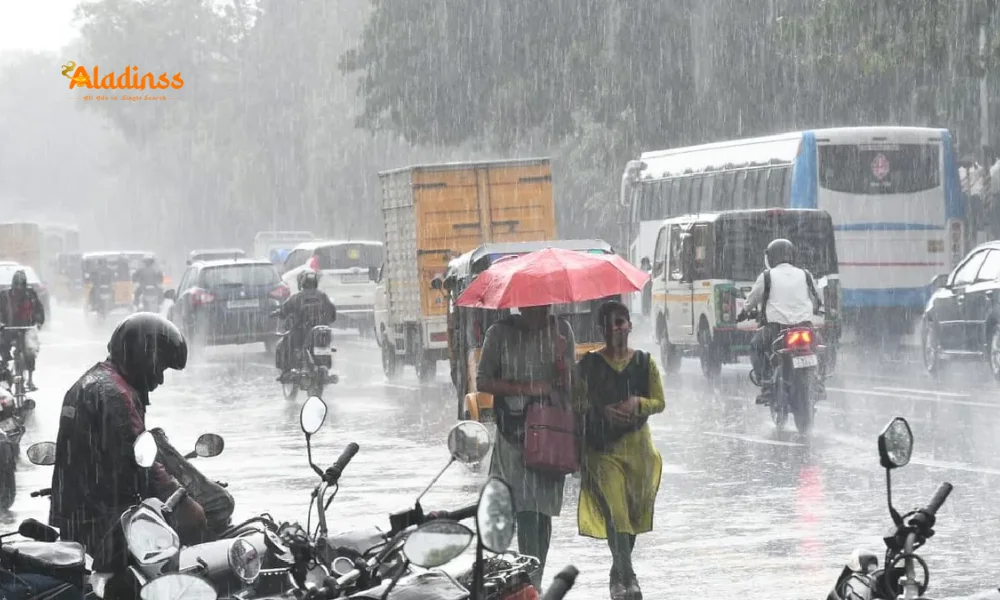Heavy Rain Alert in 10 TN Districts Today

IMD Issues Heavy Rain Alert for 10 Tamil Nadu Districts on October 8, 2025
Residents in Tamil Nadu are bracing for intense downpours as the India Meteorological Department (IMD) has forecasted heavy rain across 10 key districts today, October 8, 2025. This Tamil Nadu heavy rain alert comes amid a low-pressure system intensifying over the Bay of Bengal, promising relief from recent dry spells but also raising concerns over potential flooding and disruptions. The advisory highlights Nilgiris, Coimbatore, Theni, Dindigul, Erode, Krishnagiri, Dharmapuri, Salem, Namakkal, and Tirupattur as the most vulnerable areas, urging locals to prepare for moderate to heavy showers that could exceed 64.5 mm in isolated pockets.
The IMD's bulletin emphasizes the role of a cyclonic circulation over the southwest Bay of Bengal in driving this weather event, which could lead to waterlogging in urban centers and landslides in hilly terrains. While Chennai escapes the heaviest brunt with partly cloudy skies and chances of moderate rain, the overall pattern signals a welcome shift toward the northeast monsoon's onset. Authorities have activated emergency response teams, advising against unnecessary travel and ensuring drainage systems are cleared to mitigate risks associated with the heavy rain Tamil Nadu prediction.
This alert aligns with broader climatic trends, where erratic monsoons have become commonplace due to climate variability. Farmers in the affected districts, particularly in Coimbatore and Nilgiris, view the rains as a boon for rabi crops, yet urban dwellers worry about traffic snarls and power outages. The IMD's proactive warning underscores its commitment to public safety, drawing from advanced satellite data and Doppler radar insights for precise forecasting.

Affected Districts: Spotlight on Western Ghats and Inland Areas
The IMD's radar has pinpointed the Western Ghats belt as the epicenter of this rainfall activity, with Nilgiris and Coimbatore districts likely to witness the most intense spells. Ooty in Nilgiris, known for its misty hills, could see cloudbursts leading to swollen rivers, while Coimbatore's industrial hubs face threats from urban runoff. Further inland, Theni and Dindigul's tea estates and farmlands stand to benefit, but residents are cautioned against venturing into low-lying areas prone to flash floods.
Erode, Krishnagiri, Dharmapuri, Salem, Namakkal, and Tirupattur complete the list, where isolated heavy showers may disrupt daily commutes and agricultural operations. Historical data from IMD archives shows these regions often experience amplified rains due to orographic lift, where moist air rises over the ghats, condensing into torrents. Local administrations have stockpiled sandbags and deployed NDRF teams in high-risk zones, echoing responses to similar events in 2023 that caused widespread inundation.
Beyond immediate impacts, this rain pattern could replenish groundwater tables depleted by summer heatwaves, aiding Tamil Nadu's water-scarce pockets. However, experts warn of secondary hazards like soil erosion in deforested slopes of Dharmapuri and Salem, calling for community-driven afforestation drives to build resilience.
Also Read: Carney Praises Trump on India-Pakistan Peace
Chennai Weather Outlook: Moderate Rains Amid Partly Cloudy Skies
For the state capital, Chennai weather today promises a milder affair with partly cloudy conditions dominating, interspersed with bouts of moderate rainfall. The IMD anticipates showers totaling 7.6 to 35.5 mm, sufficient to cool the coastal humidity but unlikely to cause major disruptions. Commuters in areas like Anna Salai and Marina Beach should carry umbrellas, as evening thunderstorms remain a possibility driven by sea breezes.
This forecast contrasts with the inland deluges, offering Chennai residents a breather while neighboring Puducherry and Karaikal mirror the moderate trends. Recent upgrades to Chennai's stormwater drains, post-2015 floods, have improved resilience, yet the civic body urges vigilance against clogged outlets in older neighborhoods like Mylapore.
Meteorologists attribute Chennai's tempered rains to the city's flat topography, which disperses moisture differently from the ghat-fed interiors. Long-term, such patterns inform urban planning, with initiatives like sponge city projects aiming to harness rainwater for sustainable recharge.
Safety Tips for Urban Dwellers During Rains
To navigate the Chennai weather forecast safely, experts recommend monitoring IMD apps for real-time updates and avoiding flooded underpasses. Vehicle owners should check wiper functionality, while pedestrians opt for elevated paths.
- Secure loose items on balconies to prevent wind damage.
- Stock emergency kits with torches and non-perishables.
- Report waterlogging via municipal helplines promptly.
These measures, honed from past monsoons, empower communities to turn potential crises into manageable events.
Temperature Dip Across Tamil Nadu: Relief from Heatwave
Complementing the rains, the IMD warns of a temperature drop Tamil Nadu wide, with maximums easing by 2-3°C in select spots, settling near or below seasonal norms. This cooling trend, peaking in the western districts, could hover around 28-32°C, a welcome respite after September's sweltering highs that strained power grids and health services.
Puducherry and Karaikal echo this pattern, where humidity dips post-showers foster comfortable evenings. Climate scientists link this variability to El Niño's waning influence, paving for a robust winter crop cycle. However, abrupt shifts may trigger respiratory issues, prompting advisories for vulnerable groups to stay indoors during peaks.
Historically, such temperature drops have boosted tourism in hill stations like Ooty, where cooler climes draw escapees from the plains. Agronomists foresee enhanced yields in paddy and sugarcane, provided irrigation channels handle the influx judiciously.
Health Precautions Amid Cooling Rains
As temperatures fall, the health department flags risks like vector-borne diseases from stagnant waters.
- Use mosquito repellents and nets proactively.
- Boil drinking water to avert gastrointestinal woes.
- Consult physicians for allergy flares from mold.
These steps, integrated into IMD's outreach, safeguard public well-being during transitional weather.
Fishermen Advisory: Strong Winds Over Karnataka-Kerala and Lakshadweep Coasts
In tandem with the mainland alert, the IMD has issued a stern fishermen warning Tamil Nadu and beyond, prohibiting voyages along Karnataka-Kerala shores and Lakshadweep waters. Gusts from the cyclonic storm are projected at 40-50 kmph, gusting to 60 kmph intermittently, posing perils to small crafts and deep-sea operations.
This advisory stems from a depression brewing over the Arabian Sea, funneling squalls toward southern coasts. Fishing communities in Tuticorin and Kochi are heeding calls, mooring vessels and monitoring marine band forecasts. Economically, a day's halt impacts livelihoods, but safety trumps all, as evidenced by 2024's cyclone-induced losses.
The IMD's coastal vigilance, bolstered by buoys and satellites, ensures timely evacuations if escalation looms. Long-term, climate-resilient harbors and insurance schemes are vital for these frontline workers.
Cyclone Preparedness: Lessons from Recent Storms
Drawing from Remal and Dana's 2024 rampages, preparedness includes fortified nets and community drills.
- Secure anchors against surge tides.
- Stockpile rations for 72-hour isolations.
- Leverage apps for wind trajectory maps.
Such strategies mitigate the cyclonic storm Lakshadweep threats, fostering adaptive resilience.
Broader Impacts: Agriculture, Economy, and Climate Resilience
This IMD rain prediction Tamil Nadu event ripples through sectors. Agriculture gains from soil moisture, potentially lifting vegetable prices in Theni markets. Conversely, delayed harvests in Erode's turmeric fields could strain supply chains.
Economically, tourism in Nilgiris surges with misty allure, while transport firms prep for slick roads. Climate-wise, these rains underscore Tamil Nadu's vulnerability, spurring investments in early warning networks and green infrastructure.
As October unfolds, sustained monitoring will dictate if this heralds a bountiful monsoon or fleeting showers. For now, the Tamil Nadu heavy rain alert reminds us of nature's dual edge—nurturer and disruptor.
Stay tuned to IMD updates, and prioritize safety amid the downpour's embrace.
Comment / Reply From
No comments yet. Be the first to comment!











